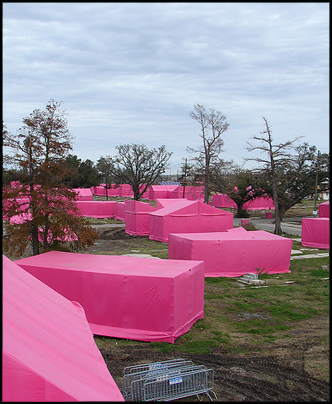
Celebrities get involved in good causes, that’s nothing new, but when Brad Pitt gets involved, things happen in a big, big way. The actor was making a movie in Canada when Hurricane Katrina and the subsequent flooding hit New Orleans. Watching the TV news coverage, he thought about all the residents who had been made homeless. He also recalled his first impressions from making a film there in 1994, when he became convinced it was the most interesting city in America, a world-class urban environment with everything going for it. Pitt said,
It’s like Venice or Rome; an essential world city.
These words were spoken on the fifth anniversary of the flood, when Pitt sat down with historian and old friend Douglas Brinkley for a long interview that was published in the New Orleans daily Times-Picayune. He talked about visiting again a couple of years after the disaster, when the city was still a zone of devastation. He said,
It was obliterationville… You know, these weren’t just houses. These were people’s lives shattered. Families in pain, memories washed away, just obliterated… I met Katrina victims who had been given FEMA trailers and had nothing to hook them up to… We were telling people to come home and yet when they got back to New Orleans they were treated in a substandard way. I just thought it was atrocious.
Pitt also voiced some unkind thoughts about the cause of the destruction, namely, shoddy work on the levees by the Army Corps of Engineers, coupled with negligence when it came to maintenance of the flood protection. He felt that if the work had been done right in the first place, fixing it would not have cost billions. There would have been fewer casualties from the storm, fewer homeless, displaced people afterwards, and a grave injustice would have been avoided.
In the Lower Ninth Ward, more than 4,000 homes had been destroyed. Pitt adopted the neighborhood as his project, and took decisive action to bring the scattered residents back. After buying a place in the French Quarter to have a base of operations, he consulted with architects, established the nonprofit Make It Right Foundation, and began making plans for the reconstruction.
The first step was taken with style and flair, in December of 2007, when the ravaged Lower Ninth was brightened up with a Christo-like art installation. The vacant, bulldozer-scraped lots suddenly sprouted a crop of glowing pink rectangular tents with fabric skins, stand-ins for the eventual real homes that would be built there.
A self-described architecture junkie, Pitt knew the right people to approach, starting with William McDonough + Partners, whose website says,
WM+P developed criteria to frame Make It Right’s environmental mission, using Cradle to Cradle thinking to outline design and systems performance requirements for each home, achieving the goal of LEED Platinum certification for all of the houses.
Translated from architect-speak, that means “state of the art.” A dozen other firms were brought into the project too. As Pitt says, “The holy grail of architecture is finding ways to design sustainable urban communities,” and these were the experts to do it. Now the local New Orleans contractors and builders are up to speed on green building principles and techniques. The goal is to wind up with 150 new homes in the Lower Ninth, and then perhaps to expand the project into St. Bernard Parish.
This wouldn’t apply to “green” homes everywhere, but for the particular area, the structures are elevated enough to endure flooding. Solar panels provide energy for homes that are so high-performance, they produce more energy than they consume, without polluting. According to the Green Building Council, the Lower Ninth Ward is now the most high-performing clean neighborhood that exists anywhere. The next step, Pitt says, is to bring the price down, which will do a lot toward encouraging other communities to follow the template.
Make It Right‘s own website goes into more detail about how the organization is committed to making a difference. Along with houses surrounded by native landscaping, the foundation is creating new streets, rain gardens, and micro-farms, and working with schools and community centers, adding up to…
[…] a unique laboratory for testing and implementing new construction techniques, technologies and materials that will make green, storm resistant homes affordable and broadly available to working families in communities across America.
Through the generosity of architects from around the world, and the donations of many individuals, the homeless residents are able to return, and the neighborhood is becoming a model of innovative and sustainable design.
The website includes an amazing map, where a little circle pops up on the page to mark every house that has been rebuilt. If you’re into architecture, design, urban planning, or green living in general, the slide shows of each home in its various stages of construction are fascinating.
There is a book about the progress that has been made so far, sharing information about the practical building designs, how to maximize value in the economic, ecological, and social realms all at once, and technological solutions that can be adapted in different parts of the world where sustainable housing is sorely needed. Like the formerly homeless New Orleans residents, others can take hope from the advances that have been made here.
Reactions?
Source: “Brad Pitt talks about Hurricane Katrina, his Make it Right work and his love for New Orleans,” NOLA.com, 08/25/10
Source: “Make It Right,” McDououghPartners.com
Source: “Our Work and Progress,” MakeItRightNOLA.org
Source: “Architecture in Times of Need – Make It Right Rebuilding New Orleans‚ Lower Ninth Ward,” MakeItRightNOLA.org
Image by Howie Luvzus, used under its Creative Commons license.
